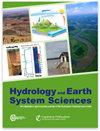水文连通性控制了泥炭地主导的北方流域流中溶解有机碳的出口
IF 5.8
1区 地球科学
Q1 GEOSCIENCES, MULTIDISCIPLINARY
引用次数: 1
摘要
摘要从北方泥炭地通过侧向地下流向河流输出的溶解有机碳(DOC)的大小在无冰季节有所不同。泥炭地地下水位深度和泥炭排水溪流中高低流量的交替被认为是驱动DOC输出变化的因素。然而,考虑到集水区内多个潜在的DOC来源,泥炭地出口DOC的具体计算可能具有挑战性。一种基于泥炭与河流之间水文连通性的计算方法可以帮助解决这一问题,这是本研究中使用的方法。这项研究于2018年6月至2019年10月在加拿大东北部的一个北方集水区进行,76.7%的集水区被营养型泥炭地覆盖。研究目标是:(1)建立源流DOC输出与泥炭地水文之间的关系;(2)在流域尺度上,量化向排水流输出的DOC量;(3)确定高流量事件时DOC的动员模式。在泥炭地源流出口,采用荧光溶解有机质(fDOM)传感器对DOC浓度进行高频(每小时)监测。水文变量,如河流出口流量和泥炭地地下水位深度(WTD),连续监测每小时间隔2年。我们的研究结果强调了从泥炭到河流的地下流动的直接和延迟控制以及相关的DOC输出。降雨事件提高了泥炭地WTD,增加了泥炭地与河流之间的水文连通性。这导致水流流量(Q)增加,DOC浓度增加延迟,这是典型的侧向地下水流。WTD的增加幅度对DOC出口量的影响至关重要。基于泥炭地是流域尺度DOC输出的最重要贡献者,而其他DOC来源在高流量期可以忽略不计的观察结果,我们提出了一种新的方法,通过区分高流量和低流量期间用于计算的表面来估计泥炭地的具体DOC输出。在2018-2019年,92.6%的DOC在洪水事件期间出口,尽管这些洪水事件占该期间的59.1%。2019-2020年,洪水期间出口了93.8%的DOC,占同期的44.1%。我们对个别洪水事件的分析揭示了三种类型的事件和DOC的动员模式。第一种类型的特征是高降雨量,导致WTD显著增加,有利于泥炭地和河流之间的联系,并导致高DOC出口。第二个特征是在之前的事件耗尽了可转移到流中的DOC之后,WTD大幅增加,导致DOC出口减少。第三种类型对应于低降雨事件,WTD增加不足以重新连接泥炭地和河流,导致低DOC输出。研究结果表明,DOC出口对水文气候条件敏感;此外,洪水事件、降雨制度、无冰季持续时间和孔隙水温度的变化可能会影响输出的DOC,从而部分抵消泥炭地的净固碳潜力。本文章由计算机程序翻译,如有差异,请以英文原文为准。
Hydrological connectivity controls dissolved organic carbon exports in a peatland-dominated boreal catchment stream
Abstract. The magnitudes of dissolved organic carbon (DOC) exports from boreal peatlands to streams through lateral subsurface flow vary during the ice-free season. Peatland water table depth and the alternation of low and high flow in peat-draining streams are thought to drive this DOC export variability. However, calculation of the specific DOC exports from a peatland can be challenging considering the multiple potential DOC sources within the catchment. A calculation approach based on the hydrological connectivity between the peat and the stream could help to solve this issue, which is the approach used in the present research. This study took place from June 2018 to October 2019 in a boreal catchment in northeastern Canada, with 76.7 % of the catchment being covered by ombrotrophic peatland. The objectives were to (1) establish relationships between DOC exports from a headwater stream and the peatland hydrology; (2) quantify, at the catchment scale, the amount of DOC laterally exported to the draining stream; and (3) define the patterns of DOC mobilization during high-river-flow events. At the peatland headwater stream outlet, the DOC concentrations were monitored at a high frequency (hourly) using a fluorescent dissolved organic matter (fDOM) sensor, a proxy for DOC concentration. Hydrological variables, such as stream outlet discharge and peatland water table depth (WTD), were continuously monitored at hourly intervals for 2 years. Our results highlight the direct and delayed control of subsurface flow from peat to the stream and associated DOC exports. Rain events raised the peatland WTD, which increased hydrological connectivity between the peatland and the stream. This led to increased stream discharge (Q) and a delayed DOC concentration increase, typical of lateral subsurface flow. The magnitude of the WTD increase played a crucial role in influencing the quantity of DOC exported. Based on the observations that the peatland is the most important contributor to DOC exports at the catchment scale and that other DOC sources were negligible during high-flow periods, we propose a new approach to estimate the specific DOC exports attributable to the peatland by distinguishing between the surfaces used for calculation during high-flow and low-flow periods. In 2018–2019, 92.6 % of DOC was exported during flood events despite the fact that these flood events accounted for 59.1 % of the period. In 2019–2020, 93.8 % of DOC was exported during flood events, which represented 44.1 % of the period. Our analysis of individual flood events revealed three types of events and DOC mobilization patterns. The first type is characterized by high rainfall, leading to an important WTD increase that favours the connection between the peatland and the stream and leading to high DOC exports. The second is characterized by a large WTD increase succeeding a previous event that had depleted DOC available to be transferred to the stream, leading to low DOC exports. The third type corresponds to low rainfall events with an insufficient WTD increase to reconnect the peatland and the stream, leading to low DOC exports. Our results suggest that DOC exports are sensitive to hydroclimatic conditions; moreover, flood events, changes in rainfall regime, ice-free season duration, and porewater temperature may affect the exported DOC and, consequently, partially offset the net carbon sequestration potential of peatlands.
求助全文
通过发布文献求助,成功后即可免费获取论文全文。
去求助
来源期刊

Hydrology and Earth System Sciences
地学-地球科学综合
CiteScore
10.10
自引率
7.90%
发文量
273
审稿时长
15 months
期刊介绍:
Hydrology and Earth System Sciences (HESS) is a not-for-profit international two-stage open-access journal for the publication of original research in hydrology. HESS encourages and supports fundamental and applied research that advances the understanding of hydrological systems, their role in providing water for ecosystems and society, and the role of the water cycle in the functioning of the Earth system. A multi-disciplinary approach is encouraged that broadens the hydrological perspective and the advancement of hydrological science through integration with other cognate sciences and cross-fertilization across disciplinary boundaries.
 求助内容:
求助内容: 应助结果提醒方式:
应助结果提醒方式:


